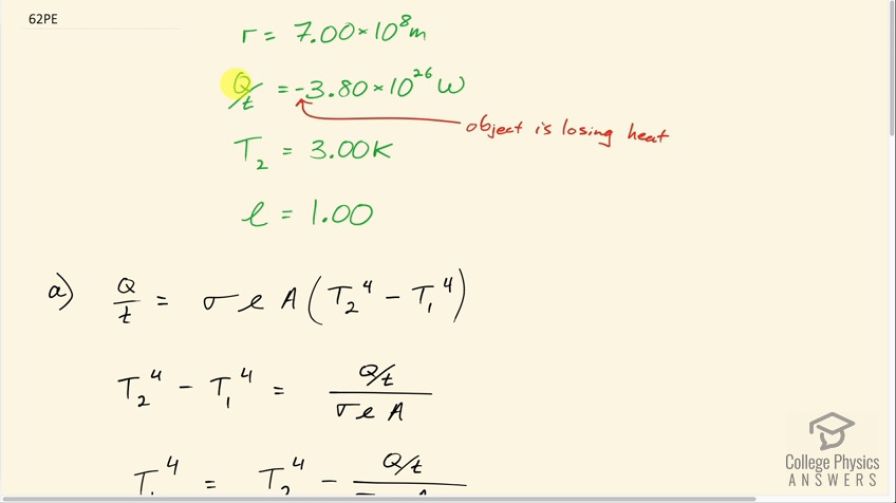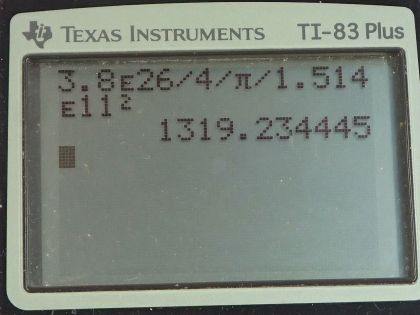Question
The Sun radiates like a perfect black body with an emissivity of exactly 1. (a) Calculate the surface temperature of the Sun, given that it is a sphere with a radius that radiates into 3-K space. (b) How much power does the Sun radiate per square meter of its surface? (c) How much power in watts per square meter is that value at the distance of Earth, away?
(This number is called the solar constant.)
Final Answer
Solution video
OpenStax College Physics for AP® Courses, Chapter 14, Problem 62 (Problems & Exercises)

vote with a rating of
votes with an average rating of
.
Calculator Screenshots
Video Transcript
This is College Physics Answers with Shaun Dychko. The Sun is a sphere with the radius of 7 times 10 to the 8 meters and it has a net radiation of 3.80 times 10 to the 26 watts and we put a negative sign there to indicate that it's losing heat to the surrounding space which has a temperature of 3 degrees Kelvin or I should say just 3 Kelvin... not use the word 'degrees' by the way. Okay! So the emissivity of the Sun is a perfect 1.00 it says. So we are meant to find the temperature of the Sun knowing that it has a net radiation of this amount to an environment at this temperature. So we can say that the rate of heat loss due to radiation is Stefan-Boltzmann's constant multiplied by the emissivity multiplied by the surface area of the Sun and since it's a sphere, its surface area will be 4π times the radius squared and then we'll multiply that by the temperature of the space to the power of 4 minus the temperature of the Sun to the power of 4 and it's this T 1 that we want to solve for. So we'll divide both sides by σ times e times A and I am gonna keep this Q over t as a single thing... it's this single number here so we'll just take this Q over t and divide the whole fraction by σeA and then switch the sides around as well. So then we wanna solve for T 1 to the power of 4, to begin with, and so add T 1 to the power of 4 to both sides and then subtract this whole fraction from both sides so it goes to the left and then switch the sides around and we end up with T 1 to the power of 4 on its own on one side and T 2 to the power of 4 minus Q over t over σeA on the other side. Now the area of a sphere is 4πr squared so we can plug that in for A and I also took the fourth root of both sides so this to the power of one quarter equals this to the power of one quarter and T 1 to the power of 4 to the power of one quarter becomes T 1 to the power of 1 and all of that equals the right hand side to the power of one quarter so then we plug in numbers. So that's 3.00 Kelvin to the power of 4 minus negative 3.80 times 10 to the 26 watts divided by 5.67 times 10 to the minus 8 times 1 for the emissivity times 4π times 7.00 times 10 to the 8 meters— radius of the spherical Sun—squared and all that to the power of one quarter gives 5.74 times 10 to the 3 Kelvin so it's about 6000 Kelvin on the surface of the Sun. Now in part (b), we are asked how much does the Sun radiate per area or per square meter on its surface? So we take that total power that we are given at the beginning and divide it by the surface area of the Sun and that surface area is 4πr squared. So it's 3.80 times 10 to the 26 watts divided by 4π times 7.00 times 10 to the 8 meters squared and that's 6.17 times 10 to the 7 watts per square meter. And in part (c), the radius that we use in our area is going to be the distance from the Earth to the Sun now. So we imagine that the same power output is now being spread over a sphere with a radius equal to the Earth-Sun distance. So that's 3.80 times 10 to the 26 watts divided by 4π times 1.514 times 10 to the 11 meters squared— this is the distance from the Earth to the Sun— and this works out to 1.32 times 10 to the 3 watts per square meter. This, by the way, has a name -- it's called the 'Solar Flux', the amount of radiative energy per second per meter squared.

